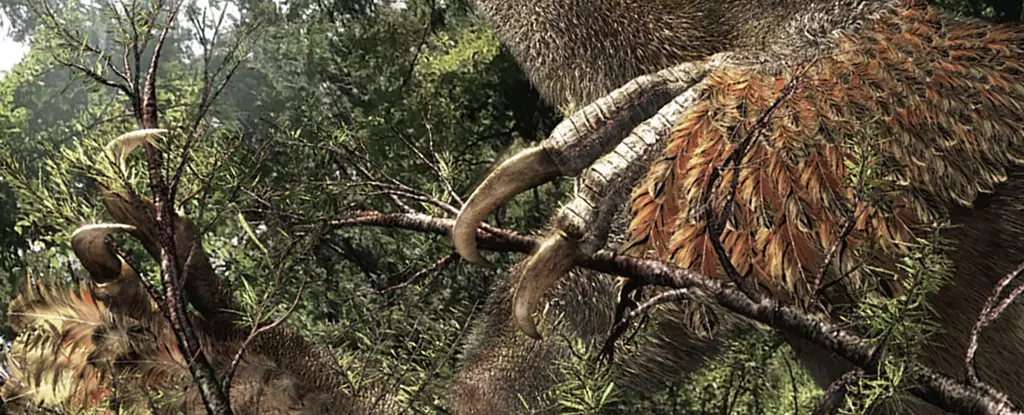The announcement of Duonychus tsogtbaatari—an extraordinary new species of bipedal dinosaur from the Cretaceous period—has sent ripples through the paleontological community. With its remarkably preserved two-fingered hands equipped with oversized talons, the discovery raises significant questions about evolutionary pathways in theropod dinosaurs. This dinosaur isn’t just another fossil; it’s a piece of a larger puzzle, providing insights into the diverse adaptations that prehistoric life underwent millions of years ago.
Discovered in the Gobi Desert and hailing from an area famously rich in dinosaur fossils, the Duonychus serves as a reminder that the natural world has a propensity for variability. The fossil’s well-preserved quality, showcasing its keratin-sheathed claws, presents a unique opportunity to study the evolutionary adaptations that occurred within therizinosaurs. Unlike its three-fingered relatives, Duonychus represents a striking divergence that might challenge long-held perceptions of functional anatomy among members of this dinosaur family.
The Implications of Losing a Finger: A Glimpse into Evolutionary Trade-Offs
The very notion of a dinosaur morphing from the standard three fingers to a mere duo is tantalizing. Most evolutionary adaptations occur for specific purposes, often improving efficiency in feeding or locomotion. Duonychus, with its uniquely configured two-fingered hands, raises a host of questions about its lifestyle and ecological niche. Initially, one might assume that a reduction in digits could signify a lack of evolutionary success. However, could this actually represent a sophisticated adaptation for grasping and pulling vegetation closer to its mouth? The implications challenge us to reconsider what we believe about survival strategies in prehistoric times.
Scientists propose that these unusual adaptations in Duonychus could be linked to its feeding strategies. Its claws, which measure a staggering 30 centimeters long, aren’t just for show; they might be strategically designed for “hook-and-pull” behavior, allowing the dinosaur to thrive in its environment. This adaptation recalls the foraging techniques of modern organisms like sloths and chameleons. It compels us to confront the complexity of evolution: that sometimes, losing a part of our anatomy can grant us a new, vital capability to succeed in a changing world.
A Window into the Past: The Role of Fossils in Understanding Diversity
The fossil record is a crucial lens through which we view prehistoric life. Each new discovery contributes to a richer understanding of biodiversity and evolutionary history. Duonychus tsogtbaatari emerges as a living mosaic of form and function, expressing traits previously unseen in therizinosaurs. Its discovery is emblematic of how much we still have to learn about the prehistoric epoch that governed our planet.
With about 90 to 95 million years of history behind it, the fossil dates back to a time when the Earth was organized quite differently. This astonishing two-fingered dinosaur, alongside other giants of its era, showcases the evolutionary experimentation that flourished during the Cretaceous. Researchers have unearthed the potential for diverse adaptations among theropods, revealing a plethora of survival strategies that echo through to modern ecosystems.
Beyond Claws: The Multifunctional Role of Adaptations
While many may view the formidable claws of Duonychus primarily as tools for feeding, it’s essential to consider that such adaptations often carry multiple meanings. The claws could have played roles in social interactions, whether for territorial displays, courtship, or even play. Just as the anatomy of living creatures can provide insights into their behavior, the unique adaptations of Duonychus challenge us to explore the myriad functions evolutionary traits may occupy.
Understanding that claws might not merely serve one purpose but instead exist as multifaceted tools encourages a broader dialogue about adaptation and survival strategies. The implications stretch into modern evolutionary biology, where adaptability remains a cornerstone of survival.
The emergence of Duonychus tsogtbaatari opens the door to dynamic discussions about evolutionary pathways, inviting both researchers and enthusiasts alike to reexamine preconceived notions of dinosaur morphology and behavior. Each discovery, like this iconic two-fingered dinosaur, challenges the narrative and urges us to embrace the nuanced interplay of form, function, and environment in the ongoing saga of life on Earth.


Leave a Reply